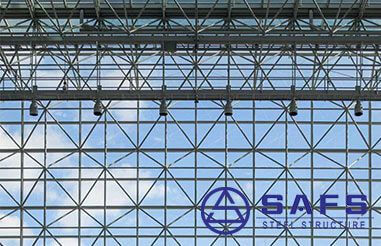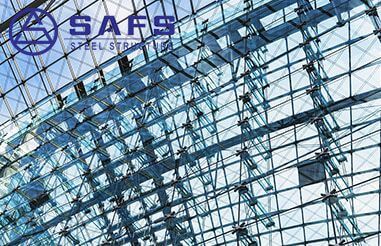Dapeng Town Industrial Park, Tongshan District, Xuzhou City, Jiangsu Province, China
Steel frame glass curtain wall has become a very characteristic and advantageous form of exterior wall decoration in modern buildings.
In terms of visual effect, it gives the building a unique sense of beauty and modernity. Steel frame lines are simple and hard, and transparent or translucent glass panels reflect each other, creating a simple and bright, light and transparent appearance. Whether it is a regular rectangular building or a creative shaped building, steel frame glass curtain wall can be cleverly designed and combined to show the personality and charm of the building, becoming a bright landscape in the city. For example, in some landmark commercial buildings or cultural venues, the curtain wall design often becomes the focus of people’s attention, highlighting the building’s high-end atmosphere and fashion taste.

In terms of functional performance, excellent lighting performance is one of its major highlights. Glass curtain wall can introduce a large amount of natural light, so that the indoor space is bright and open, reducing the dependence on artificial lighting during the day, not only energy saving, but also provide users with a more comfortable, natural indoor environment. Moreover, with the development of technology, curtain wall glass has also made great progress in thermal and acoustic insulation. The use of double-layer insulating glass or even multi-layer composite glass structure, and filled with special gases, can effectively block heat conduction, maintain a stable indoor temperature, reduce air-conditioning energy consumption; and at the same time can block external noise, so that the interior to remain quiet, in the busy city building inside the building to create a quiet spatial atmosphere, such as hotels, office buildings, and other buildings with high demand for these functions, the steel-framed glass curtain wall can be very good to meet.
Structurally, the steel frame provides a solid support system for the glass curtain wall. Steel has high strength, good toughness and plasticity, and can withstand large wind loads, seismic forces and other external forces. The structural form of steel frame is rich and diverse, and can be flexibly designed and optimised according to the scale, height and shape of the building. Like high-rise and ultra-high-rise buildings, structural forms such as lattice-type steel frames or giant steel frames are often used to enhance the overall lateral force resistance and stability of the curtain wall and ensure the safety of the building in extreme weather or geological disasters. The connection nodes between the glass and steel frame are carefully designed and constructed to ensure the integrity and reliability of the curtain wall system.

However, there are some limitations in the application of steel-framed glass curtain wall. Its relatively high cost, steel and high quality glass itself is expensive, coupled with the design, processing, installation of complex links, the need for professional technology and equipment, making the overall cost is high, limiting the application of some limited budget projects. Maintenance, due to exposure and at high altitude, the glass curtain wall needs to be regularly cleaned, check the sealing tape, hardware and other components, in order to prevent water leakage, air leakage, glass self-explosion and other issues, high-level curtain wall cleaning and maintenance work is difficult and dangerous. In addition, large-area glass curtain walls may produce light pollution in direct sunlight, causing visual interference to the surrounding environment and pedestrians, affecting traffic safety and residents’ lives.
However, overall, steel frame glass curtain wall occupies an important position in the field of building facade decoration by virtue of its unique aesthetic value, good functional characteristics and reliable structural support. With the continuous progress of material science and building technology, its cost is expected to be further reduced, performance will continue to optimise, light pollution and other issues will gradually get a better solution, the future will certainly shine in more buildings, providing more possibilities for the perfect combination of architectural art and function.